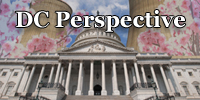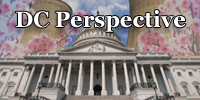Be the change you want to see in the world
What does it mean to be a leader? That question is at the heart of the Young Professionals Congress 2019 (YPC19).

What does it mean to be a leader? That question is at the heart of the Young Professionals Congress 2019 (YPC19).
Sometimes it feels like we're fighting an uphill battle for nuclear energy - and perhaps we are.
Two bipartisan pieces of legislation modernizing America's nuclear future have recently become law. It's still a long way from pushing nuclear builds the way we need to address a host of environmental issues, but it is a good start.
 In January, the U.S. Environmental Protection Agency issued an Advanced Notice of Proposed Rulemaking (ANPR) concerning 40 CFR 190-the regulations that govern public exposure and release of radioactive materials resulting from normal nuclear power plant operations (it does not pertain to nuclear accidents). The public comment period for the proposed rulemaking ended on August 3.
In January, the U.S. Environmental Protection Agency issued an Advanced Notice of Proposed Rulemaking (ANPR) concerning 40 CFR 190-the regulations that govern public exposure and release of radioactive materials resulting from normal nuclear power plant operations (it does not pertain to nuclear accidents). The public comment period for the proposed rulemaking ended on August 3.
 With cap-and-trade and carbon tax proposals going nowhere in congress, the Obama administration is tackling the global warming issue through the administrative branch, using U.S. Environmental Protection Agency regulations. In the transport sector, the administration promulgated vehicle fuel efficiency (mileage) standards. In the power sector, the EPA has proposed regulations requiring that all new power plants emit no more CO2 than a typical natural gas plant-thus, any new coal plants would have to employ CO2 sequestration. And now, the EPA is proposing to address CO2 emissions from existing power plants by establishing CO2 emissions reduction requirements for the power sector.
With cap-and-trade and carbon tax proposals going nowhere in congress, the Obama administration is tackling the global warming issue through the administrative branch, using U.S. Environmental Protection Agency regulations. In the transport sector, the administration promulgated vehicle fuel efficiency (mileage) standards. In the power sector, the EPA has proposed regulations requiring that all new power plants emit no more CO2 than a typical natural gas plant-thus, any new coal plants would have to employ CO2 sequestration. And now, the EPA is proposing to address CO2 emissions from existing power plants by establishing CO2 emissions reduction requirements for the power sector.
 In February, the U.S. Department of Energy finally announced the approval of a federal loan guarantee for the Vogtle-3 and -4 reactor project under construction near Waynesboro, Ga. The approval came after four years of negotiations between the government and the utilities involved in the Vogtle project.
In February, the U.S. Department of Energy finally announced the approval of a federal loan guarantee for the Vogtle-3 and -4 reactor project under construction near Waynesboro, Ga. The approval came after four years of negotiations between the government and the utilities involved in the Vogtle project.
 With the recent shutdown of four reactors and another scheduled closure later this year, there is increasing concern over nuclear plant shutdowns in the United States, and the idea of policy intervention to prevent further closures is gaining political traction.
With the recent shutdown of four reactors and another scheduled closure later this year, there is increasing concern over nuclear plant shutdowns in the United States, and the idea of policy intervention to prevent further closures is gaining political traction.
At this site in January, I made the case that there is significant and persistent prejudice against nuclear power among both the public and policymakers. In February, I discussed several approaches to ameliorating nuclear's current and future problems (which are largely due to said prejudice) and the limitations of each approach. This month, I will explore one last possible option: challenging the biased and unfair treatment of nuclear under current policies and regulation-in court.
In last month's post, I made the case that there is substantial prejudice against nuclear power among much of the public in most of the world. As a result, nuclear is held to requirements thousands of times as strict as other energy sources and industries, resulting in nuclear being rendered less competitive economically. This in turn results in the use of fossil generation instead of nuclear, despite the fact that the operational record, the data, and all scientific analyses show fossil-fueled generation to be orders of magnitude more dangerous and harmful.
 A United States appellate court recently handed down two long-awaited rulings with respect to Yucca Mountain. As most observers expected, both decisions were decidedly in nuclear's favor.
A United States appellate court recently handed down two long-awaited rulings with respect to Yucca Mountain. As most observers expected, both decisions were decidedly in nuclear's favor.
 Rod Adams posted a good article on this site about the situation in Europe with respect to CO2 emissions reductions and the electricity market in general. Here, I'll share my own, additional perspectives.
Rod Adams posted a good article on this site about the situation in Europe with respect to CO2 emissions reductions and the electricity market in general. Here, I'll share my own, additional perspectives.
 Most of you are well aware that Entergy recently announced it will permanently close its Vermont Yankee (VY) nuclear plant. The primary reasons given were continued low natural gas prices, the cost of post-Fukushima upgrades, and "flaws" in the local wholesale electricity market that suppress prices and harm the profitability of baseload facilities like VY. VY was close to breaking even this year, as well as the last few years, but was projected to become unprofitable in the future-over the next few years, anyway.
Most of you are well aware that Entergy recently announced it will permanently close its Vermont Yankee (VY) nuclear plant. The primary reasons given were continued low natural gas prices, the cost of post-Fukushima upgrades, and "flaws" in the local wholesale electricity market that suppress prices and harm the profitability of baseload facilities like VY. VY was close to breaking even this year, as well as the last few years, but was projected to become unprofitable in the future-over the next few years, anyway.
 In this post I will expand on some of the themes I've been discussing in several previous posts-concerning what's really needed to bring down nuclear's costs, allow it to grow in the future, and contribute to reductions in CO2 emissions and air pollution.
In this post I will expand on some of the themes I've been discussing in several previous posts-concerning what's really needed to bring down nuclear's costs, allow it to grow in the future, and contribute to reductions in CO2 emissions and air pollution.

The U.S. Environmental Protection Agency just released a draft Protective Action Guideline (PAG) that sets standards and makes recommendations for the response to a large release of radioactive material into the environment (e.g., from a nuclear plant accident or a dirty bomb attack, etc.). The draft report is now out for public comments (which are due by July 15).
 The US Department of Energy has a $452 million program to share development and licensing costs for selected small modular reactor (SMR) designs. The DOE's goal is to have an operating SMR by ~2022. Last November, the DOE awarded the first grant to the B&W mPowerTM reactor. In more recent news, the DOE has decided to issue a follow-on solicitation to enter a similar cost-sharing agreement with one or more other SMR vendors (and their SMR designs). The status of development and licensing for several SMR designs are summarized below.
The US Department of Energy has a $452 million program to share development and licensing costs for selected small modular reactor (SMR) designs. The DOE's goal is to have an operating SMR by ~2022. Last November, the DOE awarded the first grant to the B&W mPowerTM reactor. In more recent news, the DOE has decided to issue a follow-on solicitation to enter a similar cost-sharing agreement with one or more other SMR vendors (and their SMR designs). The status of development and licensing for several SMR designs are summarized below.
 Owners of the (556 MW) Kewaunee nuclear plant in Wisconsin recently announced that they will be closing the plant, because it was losing money and they were unable to find another company willing to buy it.
Owners of the (556 MW) Kewaunee nuclear plant in Wisconsin recently announced that they will be closing the plant, because it was losing money and they were unable to find another company willing to buy it.
 In my September post at the ANS Nuclear Cafe, I discussed the Democratic and Republican party platforms, along with their potential impacts on nuclear energy. With the 2012 U.S. elections now behind us, this post provides a post-election follow up, and discusses the impacts of the election results on nuclear's prospects over the near- to mid-term.
In my September post at the ANS Nuclear Cafe, I discussed the Democratic and Republican party platforms, along with their potential impacts on nuclear energy. With the 2012 U.S. elections now behind us, this post provides a post-election follow up, and discusses the impacts of the election results on nuclear's prospects over the near- to mid-term.
 As I discussed in a June 20 ANS Nuclear Cafe post, a federal appeals court rejected the Nuclear Regulatory Commission's new nuclear Waste Confidence rule, and ordered the NRC to perform a more thorough evaluation that addresses potential risks and health and environmental impacts of very long term storage of nuclear waste at nuclear sites (until a final disposal option is developed).
As I discussed in a June 20 ANS Nuclear Cafe post, a federal appeals court rejected the Nuclear Regulatory Commission's new nuclear Waste Confidence rule, and ordered the NRC to perform a more thorough evaluation that addresses potential risks and health and environmental impacts of very long term storage of nuclear waste at nuclear sites (until a final disposal option is developed).